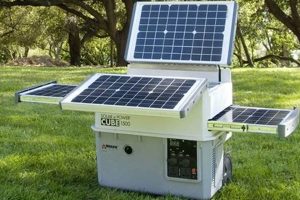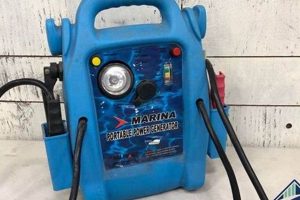Compact, independent electricity sources that eschew fossil fuels offer a range of advantages for various applications. These devices, powered by rechargeable batteries, solar panels, or fuel cells, provide a clean and silent alternative to traditional gasoline-powered generators. Examples include battery-powered inverters suitable for camping or small electronics, and solar generators capable of powering larger appliances or even homes during outages.
The rise of these alternative power sources reflects a growing need for sustainable and resilient energy solutions. Concerns about climate change and air pollution, coupled with the increasing frequency and intensity of natural disasters, have driven demand for reliable off-grid power. These devices offer crucial support during power outages, facilitating remote work, powering essential medical equipment, and maintaining communication networks. Furthermore, they enable access to electricity in areas lacking traditional grid infrastructure, empowering remote communities and supporting disaster relief efforts.
The following sections delve deeper into the different types of these power solutions, exploring their functionalities, advantages, disadvantages, and practical applications. This includes a detailed analysis of battery technologies, solar panel integration, fuel cell operation, and considerations for selecting the appropriate system based on specific power needs and environmental conditions.
Tips for Selecting and Using Portable, Off-Grid Power Solutions
Choosing and operating an independent power source requires careful consideration of several factors. These tips offer guidance for maximizing effectiveness and safety.
Tip 1: Calculate Power Needs: Accurately determine the wattage requirements of devices intended for connection. This ensures the selected unit provides sufficient power without overloading its capacity.
Tip 2: Consider Runtime Requirements: Evaluate the necessary duration of operation on a single charge or fuel cell. Longer runtimes necessitate larger battery capacities or alternative fuel sources.
Tip 3: Prioritize Portability: Factor in weight and dimensions, particularly if frequent transport is required. Compact designs enhance convenience and maneuverability.
Tip 4: Understand Charging Options: Examine available charging methods, including wall outlets, solar panels, or car adapters. Selecting a system compatible with diverse charging sources enhances flexibility.
Tip 5: Evaluate Safety Features: Prioritize units with built-in safeguards, such as overcharge protection, short circuit protection, and temperature regulation. These features enhance operational safety and prolong unit lifespan.
Tip 6: Research Battery Technology: Different battery chemistries offer varying lifespans, performance characteristics, and environmental impacts. Lithium-ion batteries generally offer higher energy density and longer lifespans compared to lead-acid alternatives.
Tip 7: Consider Environmental Conditions: Extreme temperatures can affect battery performance. Select a unit designed to operate within the anticipated temperature range.
Adhering to these guidelines promotes informed decision-making, ensuring safe and effective utilization of off-grid power solutions, maximizing their benefits and longevity.
By understanding the various factors influencing performance and safety, users can confidently select and operate a system tailored to their specific power needs.
1. Power Output
Power output, measured in watts, represents a critical specification for gasless portable power generators. This metric directly dictates the types and number of devices the generator can power simultaneously. A higher wattage signifies the capability to handle more demanding electrical loads, such as power tools or larger appliances. Conversely, lower wattage units suffice for smaller electronics like smartphones or laptops. Understanding power output is essential for matching the generator to the intended application. For example, a generator with a 1000-watt output could power a refrigerator during a power outage, while a 200-watt unit might only suffice for charging smaller devices. Mismatched power output can lead to overloading and potential damage to both the generator and connected equipment.
The power output of a gasless portable generator is also closely tied to its battery capacity and runtime. Higher power output often translates to faster battery depletion. Consequently, users requiring extended operation must prioritize generators with higher battery capacities or supplement with solar charging capabilities. For instance, construction workers using power tools might require a higher wattage output and a larger battery capacity compared to campers who primarily need to charge phones and run small lights. Practical applications dictate the necessary balance between power output, runtime, and portability.
Selecting a gasless portable power generator requires careful consideration of power output relative to anticipated usage. Evaluating power requirements for each device and considering simultaneous usage helps determine the appropriate generator size. This informed approach ensures efficient power delivery, prevents overloading, and maximizes the generator’s operational lifespan. Ultimately, understanding power output empowers users to choose a generator that meets their specific power demands, ensuring reliable and sustainable off-grid electricity.
2. Battery Capacity
Battery capacity, typically measured in watt-hours (Wh) or ampere-hours (Ah), fundamentally determines the duration a gasless portable power generator can operate before requiring recharge. This capacity represents the stored energy available to power connected devices. Higher capacity translates to longer runtimes, enabling extended use without access to external charging sources. This characteristic becomes crucial in scenarios such as camping trips, power outages, or remote work situations. For instance, a generator with a 500Wh battery might power a laptop for several hours, while a 2000Wh unit could operate a small refrigerator overnight. Capacity directly influences operational independence and usability.
The relationship between battery capacity and power output influences practical application. A generator with high power output but limited battery capacity will deplete rapidly under heavy load. Conversely, a unit with lower power output can operate for extended periods with a smaller battery. Understanding this interplay is essential for selecting an appropriate generator. A construction worker utilizing power-hungry tools requires a generator with both high power output and substantial battery capacity. Conversely, someone seeking to charge smaller devices during a short-term power outage benefits from a smaller, lighter unit with lower capacity. The balance between capacity, output, and portability depends entirely on the anticipated application.
Effective utilization necessitates understanding the factors impacting battery capacity. Environmental conditions, such as temperature, can influence performance. Extreme cold can reduce effective capacity. Furthermore, battery lifespan, measured in charge cycles, degrades over time. Regularly discharging a battery to its limit accelerates this degradation. Therefore, understanding capacity requirements and usage patterns optimizes generator selection, maximizes operational lifespan, and ensures reliable power delivery in diverse situations. Careful capacity planning ensures that power demands are met effectively and efficiently.
3. Portability
Portability represents a defining characteristic of gasless portable power generators, directly influencing their suitability for various applications. The ease with which these units can be transported and deployed significantly impacts their practical utility. This section explores the key facets of portability and their implications for effective generator selection and utilization.
- Weight and Dimensions
The physical size and weight of a generator dictate its maneuverability and transportability. Compact, lightweight designs are ideal for applications requiring frequent movement, such as camping, backpacking, or on-site work. Conversely, larger, heavier units, while potentially offering greater capacity, might prove cumbersome in such scenarios. Manufacturers often specify weight and dimensions, enabling informed decisions based on individual needs and physical limitations. A compact generator might be easily carried in a backpack, while a larger unit might require a wheeled cart or vehicle transport.
- Integrated Handles and Wheels
Design features such as integrated handles, retractable handles, or built-in wheels significantly enhance portability. These elements facilitate easier handling and movement, particularly for heavier units. Ergonomic handles reduce strain during transport, while durable wheels enable smooth movement across various terrains. The presence and quality of these features directly impact the practical usability of the generator, especially in challenging environments or for users with physical limitations.
- Form Factor and Design
The overall form factor and design contribute to portability and storage convenience. Compact, stackable designs maximize space efficiency, while ruggedized casings protect internal components during transport and handling. Foldable solar panels integrated into some units further enhance portability. These design elements influence the generator’s suitability for different applications and storage environments. A compact, rugged design is ideal for outdoor adventures, while a stackable form factor benefits users with limited storage space.
- Impact on Application
The portability of a gasless power generator directly influences its suitability for various applications. Highly portable units are essential for remote work, outdoor events, and emergency preparedness. Less portable but higher-capacity units might be more suitable for home backup power during extended outages. The specific application dictates the acceptable trade-offs between portability, power output, and battery capacity. Emergency responders might prioritize portability for rapid deployment, while homeowners might prioritize capacity over portability for longer-duration backup power.
Careful consideration of these portability facets ensures selection of a gasless portable power generator aligned with specific needs and intended usage. Balancing portability with power output, battery capacity, and other features optimizes functionality and usability across diverse scenarios. Understanding the interplay of these elements empowers informed decisions and maximizes the benefits of portable, off-grid power solutions.
4. Charging Options
Charging options represent a critical aspect of gasless portable power generators, directly influencing their practicality and usability. The availability of diverse charging methods enhances operational flexibility and ensures power availability in various situations. Understanding the range of charging options and their respective characteristics is essential for effective generator selection and deployment.
- AC Wall Outlets
Charging via standard AC wall outlets offers a convenient and readily available method for replenishing battery capacity. This option allows users to recharge generators at home, in offices, or any location with access to mains electricity. The charging time depends on the generator’s battery capacity and the output of the charging adapter. This method provides a reliable and accessible means of maintaining generator readiness, particularly for home backup power or planned outdoor activities.
- Solar Panels
Integrating solar panels offers a sustainable and environmentally friendly charging solution, harnessing renewable solar energy. This method proves invaluable in off-grid scenarios, extending operational duration without reliance on traditional power sources. Portable solar panels, often foldable and designed for compatibility with specific generators, provide flexibility and convenience. Charging times vary depending on solar panel wattage, weather conditions, and the generator’s battery capacity. This method contributes to reduced reliance on fossil fuels and empowers extended off-grid operation.
- 12V Car Adapters
Charging through 12V car adapters offers a convenient option during travel or in situations where AC power is unavailable. This method leverages vehicle power systems to recharge generators, ensuring power availability for remote work, camping, or emergency situations. Charging times depend on the vehicle’s power output and the generator’s battery capacity. This method enhances operational flexibility, enabling power replenishment during transit or in remote locations.
- USB-C Power Delivery
USB-C Power Delivery (PD) emerges as a increasingly prevalent charging method for smaller gasless portable power generators, particularly those designed for charging portable electronics. USB-C PD enables faster charging speeds compared to traditional USB ports, reducing downtime and enhancing convenience. This method leverages the versatility of USB-C technology, streamlining charging processes for compatible devices. Utilizing USB-C PD for compatible generators offers improved charging efficiency and reduced charging times.
The diversity of charging options available for gasless portable power generators significantly enhances their versatility and practicality. Understanding the advantages and limitations of each method enables informed decisions regarding generator selection and deployment strategies. Selecting a generator with multiple charging options enhances operational flexibility and ensures power availability across a wider range of scenarios, from planned outdoor activities to unexpected power outages.
5. Safety Features
Safety features are paramount in gasless portable power generators, mitigating potential hazards associated with electricity generation and storage. These features protect both users and connected devices from harm, ensuring reliable and safe operation. Several key safety mechanisms contribute to enhanced operational security.
Overload protection prevents damage to the generator and connected equipment by automatically shutting down the unit when excessive current draw is detected. This safeguard prevents overheating and potential fire hazards. Short circuit protection similarly disconnects the circuit in case of a short, preventing damage and ensuring user safety. Over-temperature protection monitors internal temperatures and deactivates the generator if excessive heat buildup occurs, preventing thermal damage and potential fires. Battery management systems (BMS) regulate charging and discharging processes, optimizing battery lifespan and preventing overcharging or deep discharge, both of which can damage battery cells. Ventilation systems dissipate heat generated during operation, further mitigating thermal risks and ensuring efficient performance. These features collectively minimize risks associated with electricity generation and storage, enabling safe and reliable operation.
Real-world examples illustrate the critical importance of these safety features. During a power outage, an overloaded generator without overload protection could overheat and potentially ignite flammable materials. A short circuit in a connected appliance, if not for short circuit protection, could damage the generator and potentially cause electrical shock. In hot environments, over-temperature protection safeguards against thermal damage, ensuring continued operation within safe parameters. Effective battery management systems maximize battery lifespan and prevent premature failure, ensuring long-term reliability. Collectively, these safety features provide essential safeguards, minimizing potential risks and ensuring user and equipment safety. Understanding and prioritizing these safety aspects are crucial for responsible and informed generator selection and operation.
6. Durability/Lifespan
Durability and lifespan are critical factors influencing the long-term value and reliability of gasless portable power generators. These units often represent significant investments, and their ability to withstand regular use and environmental exposure directly impacts their cost-effectiveness and overall utility. Several factors contribute to the durability and operational lifespan of these devices.
Construction materials and build quality play a crucial role in determining robustness. Units constructed with high-impact plastics, robust metal frames, and weather-resistant seals exhibit greater resilience to impacts, drops, and exposure to moisture and dust. Reinforced corners and protective covers further enhance durability, safeguarding internal components from damage. Battery lifespan, typically measured in charge cycles, significantly influences the overall operational life of the generator. Factors such as charging habits, depth of discharge, and operating temperature impact battery longevity. Proper battery maintenance, including avoiding extreme temperatures and preventing complete discharge, can extend battery lifespan. The quality of internal components, such as inverters and control circuitry, also contributes to long-term reliability. High-quality components, designed for demanding applications, enhance performance consistency and reduce the likelihood of premature failure.
Practical examples illustrate the significance of durability and lifespan. A contractor regularly using a portable generator on construction sites requires a rugged unit capable of withstanding harsh conditions. A homeowner relying on a generator for backup power during outages benefits from a durable, long-lasting unit requiring minimal maintenance. In both scenarios, robust construction and long battery lifespan translate to reliable performance and reduced replacement costs over time. Investing in a durable and well-constructed gasless portable power generator ensures long-term reliability and minimizes the need for frequent repairs or replacements, ultimately maximizing value and providing consistent, dependable power when needed.
7. Environmental Impact
Gasless portable power generators offer a significantly reduced environmental footprint compared to their gasoline-powered counterparts. This advantage stems from the elimination of combustion processes and the associated emissions of greenhouse gases and other pollutants. Understanding the environmental impact of these devices necessitates considering their entire lifecycle, from manufacturing and usage to eventual disposal.
- Reduced Emissions
The most prominent environmental benefit of gasless generators lies in their elimination of direct air pollution. Unlike gasoline generators, which emit carbon monoxide, nitrogen oxides, and particulate matter, gasless options produce no harmful exhaust fumes during operation. This characteristic makes them suitable for use in enclosed spaces or areas with sensitive populations, such as campsites or disaster relief zones, without compromising air quality. The absence of combustion also significantly reduces their contribution to greenhouse gas emissions, mitigating their impact on climate change.
- Noise Pollution
Gasless generators operate significantly quieter than gasoline-powered alternatives. This reduction in noise pollution benefits both users and the surrounding environment. In noise-sensitive areas, such as residential neighborhoods or natural parks, the quiet operation of these generators minimizes disturbance to wildlife and contributes to a more peaceful environment. This characteristic is particularly valuable during extended power outages, where continuous noise from traditional generators can become disruptive and stressful.
- Sustainable Energy Sources
Many gasless portable power generators integrate seamlessly with renewable energy sources, such as solar panels. This integration further reduces environmental impact by utilizing clean, sustainable energy for charging. This aligns with broader efforts to transition towards renewable energy and minimize reliance on fossil fuels. Solar-powered gasless generators provide a truly off-grid power solution, reducing reliance on centralized power grids and promoting energy independence.
- Battery Lifecycle Considerations
While gasless generators offer significant environmental advantages during operation, the manufacturing and disposal of batteries present environmental challenges. Battery production involves resource extraction and manufacturing processes with associated environmental impacts. Responsible battery recycling programs are crucial for minimizing the environmental footprint of these devices at the end of their lifespan. Choosing generators with longer-lasting batteries and supporting battery recycling initiatives contribute to a more sustainable approach to portable power generation.
The environmental benefits of gasless portable power generators, particularly their reduced emissions and compatibility with renewable energy sources, position them as a more sustainable alternative to traditional gasoline generators. However, responsible battery lifecycle management remains crucial for minimizing their overall environmental footprint. Continued advancements in battery technology and recycling processes will further enhance the environmental sustainability of these increasingly essential power solutions.
Frequently Asked Questions
This section addresses common inquiries regarding gasless portable power generators, providing concise and informative responses to facilitate informed decision-making.
Question 1: What differentiates a gasless portable power generator from a conventional gasoline-powered generator?
Gasless portable power generators utilize battery power, solar panels, or fuel cells to generate electricity, eliminating the need for gasoline or other fossil fuels. This distinction results in quieter operation, reduced emissions, and enhanced portability. Conventional gasoline generators, conversely, rely on internal combustion engines, producing noise and exhaust fumes.
Question 2: How is the capacity of a gasless portable power generator determined?
Capacity is typically measured in watt-hours (Wh) and indicates the total amount of energy the generator can store. This metric directly relates to the runtime and the types of devices it can power. Higher watt-hour ratings indicate greater energy storage and longer potential runtimes.
Question 3: What are the primary charging methods available for these generators?
Common charging methods include standard AC wall outlets, 12V car adapters, and solar panels. Some models also support USB-C Power Delivery for faster charging. Selecting a model with multiple charging options enhances flexibility and ensures power availability in diverse situations.
Question 4: What safety features should one consider when selecting a gasless portable power generator?
Essential safety features include overload protection, short circuit protection, over-temperature protection, and battery management systems (BMS). These features protect both the generator and connected devices from potential damage and ensure user safety.
Question 5: What factors influence the lifespan of a gasless portable power generator’s battery?
Battery lifespan is affected by factors such as charging habits, depth of discharge, operating temperature, and overall battery quality. Proper maintenance and adherence to manufacturer recommendations can extend battery life.
Question 6: Are gasless portable power generators suitable for use in all weather conditions?
While many models offer some degree of weather resistance, operating temperature ranges can impact battery performance. Extreme temperatures, both hot and cold, can affect battery capacity and charging efficiency. Consulting manufacturer specifications regarding operational temperature ranges is essential.
Understanding these key aspects of gasless portable power generators facilitates informed selection and ensures optimal performance and safety. Careful consideration of individual power needs, charging options, safety features, and environmental conditions ensures selection of a generator best suited to specific applications.
The subsequent section provides a comprehensive comparison of various gasless portable power generator models currently available on the market, outlining their respective features, specifications, and performance characteristics.
Conclusion
Gasless portable power generators represent a significant advancement in portable power technology, offering a compelling alternative to traditional gasoline-powered units. Their advantages encompass reduced emissions, quieter operation, enhanced portability, and seamless integration with renewable energy sources. Careful consideration of factors such as power output, battery capacity, charging options, safety features, durability, and environmental impact empowers informed selection and ensures optimal performance across diverse applications. Understanding the interplay of these elements allows users to match specific power needs with appropriate generator capabilities, maximizing effectiveness and longevity.
As battery technology continues to evolve and renewable energy integration becomes increasingly prevalent, gasless portable power generators promise to play an increasingly vital role in meeting evolving energy demands. These devices empower individuals, businesses, and communities to access reliable, sustainable power in various settings, from remote work locations and outdoor recreational activities to emergency preparedness and disaster relief efforts. Continued innovation in this field will further refine performance, enhance sustainability, and expand the accessibility of clean, portable power solutions, fostering greater energy independence and resilience.






